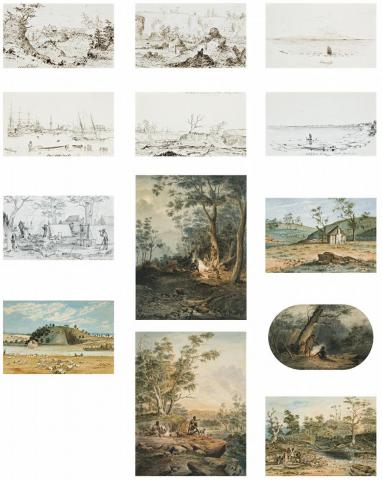A COLLECTION OF THIRTEEN MID-NINETEENTH CENTURY WATERCOLOURS AND DRAWINGS IN PEN, SEPIA INK AND PENCIL
William Rodolph Thomas
The Estate of the artist, Adelaide
Thence by descent
Maria Caroline Thomas, Adelaide
Thence by descent
Mary Dorothea Thomas, London
Thence by descent
Estate of Joan Kyffin Willington (nee Thomas), Adelaide
From North fleet in Kent, via Teneriffe to the Torrens River in Adelaide and on to the Echunga Diggings, this group of thirteen drawings and watercolours provides an absorbing and graphic record of early immigration and settlement in South Australia. In their precise, linear depiction, they are reminiscent of S. T. Gill's first drawings and watercolours of South Australia, capturing, as he did, views of Port Adelaide and pastoral life, and showing an absorbing interest in the Aboriginal peoples. By coincidence, both later went to Ballarat in Victoria. A gifted watercolourist, Thomas was born in Calcutta, India, son of Captain William Thomas of the 13th Light Infantry. Thomas' drawings and watercolours show that he had a keen eye for detail and a lively interest in his surroundings, as in North fleet, Kent where he presents himself sketching in the foreground. After his arrival in Adelaide aboard the Rajah in late 1848 or early 1849, he sketched the busy port scene with its numerous ships and boats. The River Torrens under a February summer sun followed, even more busily populated by the Adelaide tribe, dependant on the river for its food and water. (This was the same year as the arrival of that most interesting German artist Alexander Schramm (1814 - 1864), whose oil paintings of the Adelaide Aborigines number among his best.) Following his marriage to Maria Caroline Good in 1850, Thomas briefly leased the Northern Hotel on the Great North Road, worked in the Immigration Office at Port Adelaide, and wrote for the Adelaide Times. The same newspaper reported the exhibition of his watercolour of Nelson boarding the San Nicholas at Platt's Library. The work had previously been printed in aquatint in London in 1845.
The 8 April 1864 issue of the South Australian Register praised Thomas' watercolour of an Australian homestead: 'The transparent brilliancy of our South Australian sun is preserved, while the brightness is not oppressive, as the grouping of objects admits of sobering colouring, which gives a pleasing and truthful tone.'1 Later that year Thomas was appointed curator of the 8th Annual Exhibition of the South Australian Society of Arts. It included eighteen of his own works, three gaining prizes - for the best ink drawing, best pencil drawing, and the best watercolour. Another watercolour, Departure Corroboree, 1864, in the collection of the Art Gallery of South Australia, Adelaide, belongs to this time. Of similar date are the two pastoral subjects in this collection - Shepherd's Life in Australia and Humpy Hill with Quarry Cut and Small Shepherd's Hut. In Shepherd's Life the detail of the black crows' hungering view of the mutton hung up to cure is worthy of S. T. Gill. Similarly, in Humpy Hill with Quarry Cut and Small Shepherd's Hut, the enveloping atmosphere, curious geological formations, and motif of the shepherd and his dog are equal to those of Gill. The landscape in these two watercolours suggests that they relate to the 1864 commission Thomas received from the Hon. G. C. Hawker for a series of views of his Bungaree Station near Clare. A wood engraving of one of the commissioned works was published in the Illustrated Australian News of 25 April 1865.
By 1868 Thomas and his family were living in Ballarat, where he was listed as a law clerk. As Thomas died in Ballarat in 1880, one can only speculate that he painted his later watercolours there from sketches drawn previously before the motif. A typically fine example is On the Onkaparinga near Hahndorf, South Australia. The inclusion of 'South Australia' in the title may suggest it was carried out in another place. His early drawings, however, are inscribed 'SA' or 'South Australia'. These inscriptions could, of course, have been added later. By now, narrative had become important in his work and his technique broadened. At the End of the Day provides an iconic image of the time, complete with campfire, horses and a dog. Its pendant, Three Aborigines and Three Dogs on Rocky Lookout, marks the dawn of a new age as the inhabitants point anxiously at the column of smoke rising straight from the distant homestead occupying their tribal land.
1. Quoted in Appleyard, R., 'Thomas, William Randolph', in Kerr, J. (ed.), The Dictionary of Australian Artists, Oxford University Press, Melbourne, 1992, p. 793
DAVID THOMAS
